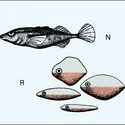TINBERGEN NIKOLAAS (1907-1988)
bibliographie
K. Lorenz & N. Tinbergen, « Taxis und Instinkthandlung in der Eirollbewegung der Graugans », in Zeitschrift für Tierpsychologie, no 2, 1938 (trad. franç. : « Taxie et action instinctive dans le mouvement de roulage de l'œuf chez l'oie grise », in K. Lorenz « Essais sur le comportement animal et humain », Seuil, Paris, 1970)
J. J. Ter Pelwijk & N. Tinbergen, « Eine reizbiologische analyse einiger verhaltensweisen von Gasterosteus aculeatus(L.) », in Z. Tierpsychol., no 1, 1937
N. Tinbergen, « Beobachtungen am Baumfalken (Falco s. subbuteo L.) », in Journal für Ornithologie, no 80, 1932 ; « Über die Orientierung des Bienenwolfes (Philanthus triangulum Fabr.) », in Zeitschrift für vergleichende Physiologie, no l.16, 1932 ; « Über die Orientierung des Bienenwolfes (Philanthus triangulum Fabr.). II. Die Bienenjagd », in Zeitschrift für vergleichende Physiologie, no 21, 1935 ; « Zur Soziologie der Silbermöwe, Larus a. argentatus Pont », in Beiträge zur Fortpflanzungsbiologie der Vögel, no 12, 1936 ; « The function of sexual fighting in birds, and the problem of the origin of 'territory' », in Bird Banding, no_7, 1936 ; « Die Übersprungbewegung », in Zeitschrift für Tierpsychologie, no 4, 1940 ; « An Objectivistic Study of the innate behaviour of animals », in Bibliotheca Biotheoretica, no 1, 1942 ; « Physiologische Instinktforschung », in Experientia, no 4, 1948 ; « The Hierarchical Organization of the nervous mechanisms underlaying instinctive behaviour », in Experimental Biology, no 4, 1950 ; The Study of Instinct. Clarendon Press, Oxford, 1951, nouvelle édition actualisée en 1989, Oxford University Press (éd. franç., Payot, Paris, 1953) ; The Herring Gull'World, Collins, Londres, 1953 (L'Étude de l'instinct, traduction française : L'Univers du goéland argenté, Elsevier Séquoia, Paris, Bruxelles, 1975) ; Social Behaviour in Animals, Londres, Methuen, 1953 ; Curious Naturalist, Country Life, Londres, 1958 ; « On aims and methods of Ethology », in Zeitschrift für Tierpsychology, no 20, 1963 ; Animal Behaviour, New York, Time Inc., Life Nature Library, 1965 ; « On war and peace in animals and man », in Science, no 160, 1967 ; The Animal in its World : Explorations of an Ethologist 1932–1972. Vol.1 :Field studies.Vol. 2 :Laboratory Experiments and General Papers, Allen & Unwin Londres, 1972
N. Tinbergen & J. J. A. Iersel, « Displacement reactions in the three-spined stickleback », in Behaviour, no 1, 1947
N. Tinbergen & D. J. Kuenen, « Über die auslösenden und die richtung gebenden Reizsituationen der Sperrbewegung von jungen Drosseln (Turdus m. merula L. und T. e. ericetorum Turton) », in Zeitschrift für Tierpsychologie, no 3, 1939
N. Tinbergen & E. A. Tinbergen, « Early Childhood Autism – an ethological approach », in Ethology suppl., no 10, 1972 ; Autistic children : new hope for a cure, Georg Allen & Unwin, Londres, 1983.
La suite de cet article est accessible aux abonnés
- Des contenus variés, complets et fiables
- Accessible sur tous les écrans
- Pas de publicité
Déjà abonné ? Se connecter
Écrit par
- Raymond CAMPAN : professeur honoraire à l'université Paul-Sabatier, Toulouse
Classification
Pour citer cet article
Raymond CAMPAN. TINBERGEN NIKOLAAS (1907-1988) [en ligne]. In Encyclopædia Universalis. Disponible sur : (consulté le )
Média
Autres références
-
COMPORTEMENT ANIMAL - Fondements du comportement
- Écrit par Dalila BOVET
- 2 830 mots
- 5 médias
...goélands donnent des coups de bec sur une tache rouge située sur le bec de leurs parents, provoquant ainsi chez ces derniers la régurgitation de nourriture. Tinbergen montre, dès le début des années 1950, en présentant des leurres aux jeunes goélands, que la forme, la couleur ou la taille de la tête peuvent... -
ÉTHOLOGIE
- Écrit par Odile PETIT
- 2 528 mots
- 2 médias
...siècle pour la voir ériger en discipline sous le nom d'éthologie (on parle alors d'éthologie objectiviste) grâce à Konrad Lorenz (1903-1989) et Nikolaas Tinbergen (1907-1988). Le premier, souvent décrit comme le plus théoricien des deux, s'est rendu célèbre par ses travaux sur les canards et les... -
FONDEMENTS DE L'ÉTHOLOGIE
- Écrit par Raymond CAMPAN
- 251 mots
C'est par un débat contradictoire autour du concept d'instinct que l'éthologie – étude comparative du comportement animal – s'est constituée en science autonome. Elle est fondée sur les travaux de l'Autrichien Konrad Lorenz (1903-1989) et du Néerlandais Nikolaas...
-
HISTOIRE DE L'ÉTHOLOGIE - (repères chronologiques)
- Écrit par Raymond CAMPAN
- 976 mots
1854 Isidore Geoffroy Saint-Hilaire utilise pour la première fois le terme « éthologie » dans son sens actuel (étude comparative du comportement animal) pour désigner les descriptions des mœurs des animaux telles qu'elles ont été faites par Aristote, Buffon, Réaumur, G. Leroy ou Lamarck....
- Afficher les 8 références
Voir aussi




